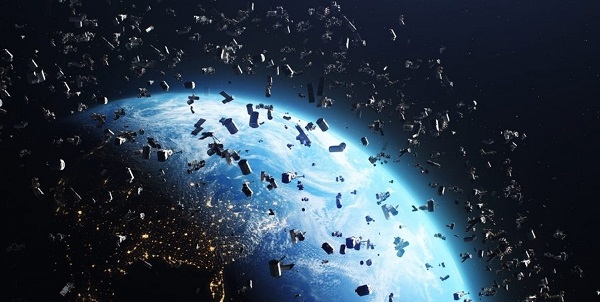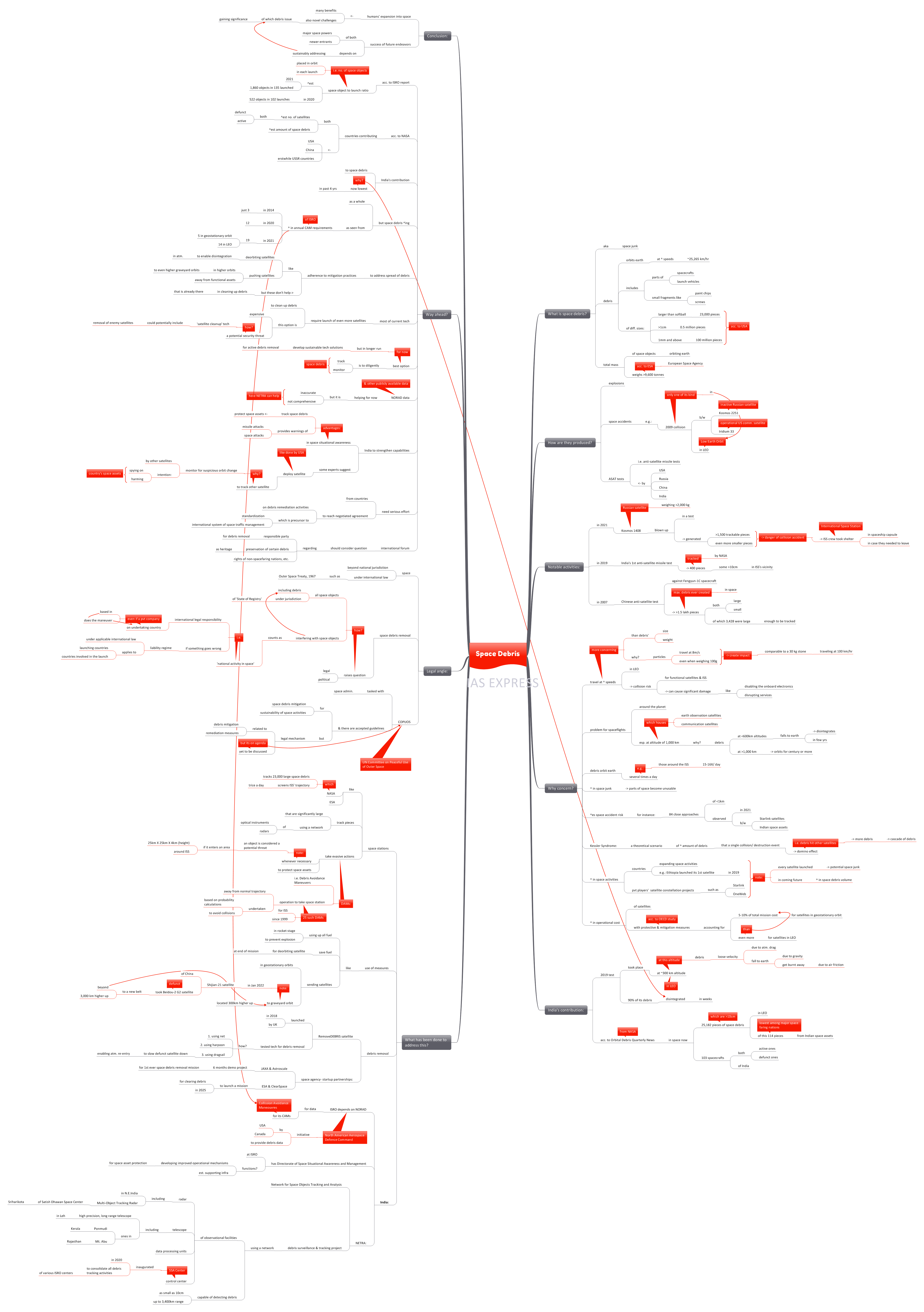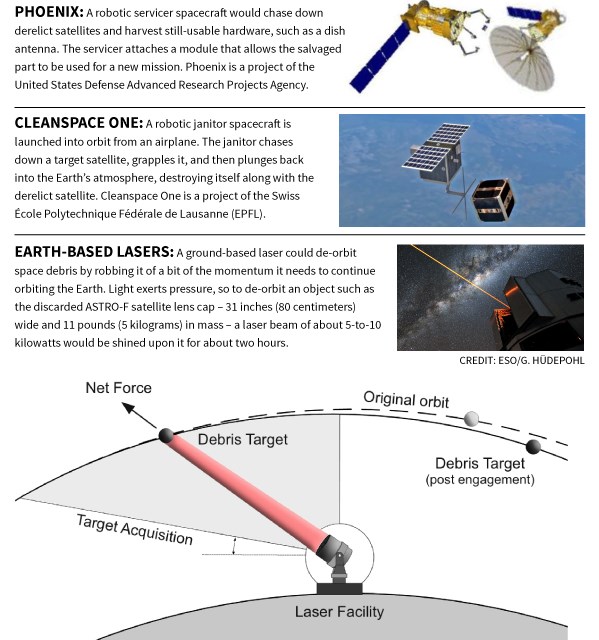Space Debris- Concerns, Contributors and Way Forward

A recent report noted that the Indian contribution to the space debris problem has sunk to 2018 levels. While this is a welcome news, the increasing space activity of not only India, but also the other established space powers and the new entrants, mean that this problem is only to grow in significance in the coming years.
This topic of “Space Debris- Concerns, Contributors and Way Forward” is important from the perspective of the UPSC IAS Examination, which falls under General Studies Portion.
What is space debris?
- Space debris or space junk is debris that orbit the earth at tremendous speeds- 25,265 kph.
- It consists of parts of spacecrafts and discarded launch vehicles. It also includes smaller fragments like paint chips and screws.
- These debris pieces are of varying sizes:
- Some 23,000 pieces are larger than a softball, according to the US government.
- About 0.5 million pieces are over 1cm
- A 100 million pieces are 1mm and above
- According to the European Space Agency, the total mass of space objects orbiting the earth weighs over 9,600 tonnes.
How are they produced?
- These are produced when explosions occur in space.
- Space accidents are another source. In 2009, the Kosmos 2251, an inactive Russian satellite, collided with Iridium 33, an operational US communication satellite. It remains the only such collision incident in the Low Earth Orbit/ LEO.
- Space junk is also generated when countries destroy their satellites using missiles (for testing purpose).
- USA, Russia, China and India are the countries that have conducted such anti-satellite missile tests.
Some notable activities that have been criticized for adding to the issue:
- In 2021, the Kosmos 1408, a satellite weigh over 2,000 kg, was blown up is a Russian test. The test is reported to have generated over 1,500 pieces that were ‘trackable’ and even more of smaller debris. In the test’s aftermath, the crew of the ISS (International Space Station) took shelter in their spaceship capsules in case they needed to leave due to a collision accident.
- In 2019, India undertook its 1st anti-satellite missile test. The NASA tracked some 400 pieces of debris from the test. Some of these pieces were reported to be over 10cm and were in the vicinity of the ISS.
- In 2007, China carried out an anti-satellite test against its Fengyun-1C spacecraft. It is noteworthy for producing the maximum debris ever created in space i.e. over 1.5 lakh pieces– large and small. Of this, 3,428 are big enough to be tracked.
Why is it a concern?
- As these debris travel at high speeds in the low earth orbit, they risk colliding with functional satellites or even the space station.
- It is to be noted that the debris’ size and weight are only secondary concerns compared to the pieces’ speed. Given that these particles travel at speeds of 8 metres per second, even a 100g object could create an impact comparable to a 30-kg stone traveling at 100kmph.
- Collisions could cause significant damage to the space properties of the countries. Upon collision, the debris disables the satellites’ onboard electronics and may disrupt the services provided by the space assets.
- The debris would pose problems for spaceflight around the planet. The risk would be highest for those orbiting at 1,000 km altitude– where most of the satellites for earth observation and communication are placed.
- While those debris orbiting the earth at altitudes below 600 km are expected to fall to earth in some years, those in altitudes over 1,000 km would continue orbiting for a century or more.
- These debris orbit the earth several times a day. For instance, the International Space Station faces debris orbiting the earth 15 to 16 times a day, in its vicinity.
- As the mass of space junk continue to grow, parts of the space may become unusable.
- There is also concern about the increasing risk of space accidents. For instance, in 2021, 84 ‘‘close approaches of less than 1 km’‘ were observed between the satellites of Starlink project and the Indian space assets.
- There is also a concern over the ‘Kessler Syndrome’– a theoretical scenario in which the amount of space debris becomes so high that a single collision or destruction event could lead to snowballing cascade of space debris- like a domino effect.
- Every satellite that is launched has the potential of becoming space junk. Countries are expanding their activities in space (eg: Ethiopia launched its first satellite in 2019) and private players are undertaking several satellite constellation projects like the Starlink and OneWeb. The coming future is set to see the volume of space debris increase.
- The space debris increases satellites’ operational cost with protective and mitigation measures accounting for 5-10% of the total mission cost for satellites in the geostationary orbit and even higher for those in the low earth orbit. This is according to OECD study.
How big of a contributor is India?
- In the 2019 test, it is to be noted that the operation took place at about 300 km altitude i.e. in the low earth orbit. Debris at such altitudes loose velocity due to atmospheric drag and succumb to earth’s gravitational force. The debris get burnt away due to air friction as they fall to the earth’s surface. Understandably, 90% of the pieces had disintegrated within weeks of the test.
- According to the latest Orbital Debris Quarterly News from NASA:
- There are now 25,182 pieces of space debris, which are more than 10 cm, in the LEO. Of this, only 114 are from Indian space assets- lowest among major space-faring nations.
- India has 103 spacecraft (including both- active and defunct ones) in orbit.
What has been done to address this issue?
- Satellites and the ISS are already at a constant risk from space objects. The space stations, like NASA and the ESA, track the significantly large pieces with the help of an elaborate network of optical instruments and radars across the world. Whenever necessary, the ground control stations take evasive actions.
- For instance, the NASA tracks some 23,000 large space debris and the ISS’s trajectory is screened atleast thrice a day. An object is considered as a potential threat if it enters an area 25 km × 25 km × 4 km (height) around the space station. DAMs or Debris Avoidance Manoeuvres, which are navigation manoeuvres that take the space station away from its normal trajectory to avoid collisions, are undertaken based on the probability of collision. 25 DAMs have been carried out since 1999.
- Space agencies have been resorting to measures like using up all the fuel in a mission’s rocket stage to prevent explosions later on or saving up fuel to enable the deorbiting of satellites at the mission end.
- End-of-life satellites in the higher altitude orbits are moved to a ‘graveyard orbit’ situated 300 km higher. In January 2022, the Shijian-21 satellite of China took the defunct Beidou-2 G2 satellite to an orbit even beyond this graveyard orbit to a new belt 3,000 km higher.
- In 2018, the UK launched the RemoveDEBRIS satellite to test technologies for debris removal:
-
- By capturing the debris using a net
- By capturing the debris using a harpoon
- Using a dragsail to slow down defunct satellites and enable their re-entry into the atmosphere
- JAXA (Japan’s Aerospace Exploration Agency) and ESA have teamed up with startups to address the issue:
- JAXA and Astroscale are undertaking a 6 month demonstration project for the first-ever space debris removal mission.
- Swiss startup ClearSpace and ESA are expected to launch a mission for clearing space debris in 2025.
India:
- Currently, ISRO depends on the NORAD for performing collision avoidance manoeuvres (CAMs) on its satellites. NORAD or North American Aerospace Defense Command is an initiative of the USA and Canada. It shares debris data with many countries.
- The ISRO has a dedicated Directorate of Space Situational Awareness and Management. It is engaged in developing improved operational mechanisms for space asset protection and establishing supporting infrastructure.
- NETRA:
- ISRO is now working on the NETRA (Network for Space Objects Tracking and Analysis) Project for the surveillance and tracking of space debris.
- The project envisions a network of various observational facilities– radars, telescopes, data processing units and a control center.
- In 2020, ISRO inaugurated the new SSA (Space Situational Awareness) center. This center consolidates the various ISRO centers’ space debris tracking activities.
- This network will be able to detect and track debris as small as 10 cm, up to a range of 3,400 km.
- The plans include a long-range, high precision telescope in Leh, Ladakh and a radar in the northeast region.
- The network will also take the services of the Multi-Object Tracking Radar of the Satish Dhawan Space Centre in Sriharikota and the telescopes installed at Ponmudi and Mount Abu.
What is the legal angle on this issue?
- Space is beyond national jurisdiction and falls under the ambit of international law. The Outer Space Treaty, 1967 and the like outline the guidelines for the countries’ activities in space.
- This implies that active space debris removal raises legal questions as well as political ones. All space objects, including the defunct space debris, are under the jurisdiction of ‘State of Registry’.
- Interfering with space objects, including space debris, count as ‘national activity in outer space’ i.e. puts an international legal responsibility on the undertaking country- even if a private company in that country carried out the manoeuvre.
- If something goes wrong during such manoeuvres, a liability regimes under the applicable international law applies to not only the launching country but also other countries involved in the launch.
- The UN Committee on the Peaceful Use of Outer Space (COPUOS) is tasked with space governance and there are already accepted guidelines for space debris mitigation and sustainability of space activities.
- However, legal mechanisms related to space debris mitigation and remediation measures continue to remain simply as another item on the COPUOS agenda and nothing more.
What is the way ahead?
- According to ISRO report, 2021 accounted for the highest space object-to-launch ratio i.e. more space objects are placed in orbit per launch- 1,860 objects in 135 launches in 2021 compared to 522 objects in 102 launches in 2020.
- According to the latest NASA data, the largest number of satellites (both defunct and active ones) and the highest contribution of space debris is from the USA, China and countries of the erstwhile USSR.
- India’s contribution to space debris has declined to the lowest level in the past 4 years. This is because the debris from the 2019 test has largely disintegrated away.
- However, the issue of space debris is only gathering significance. The number of CAMs (collision avoidance manoeuvres) being required annually has been increasing over the years– just 3 in 2014 to 12 in 2020. In 2021, the ISRO performed 19 CAMs, according to the Space Situational Assessment of the space organization. Of these operations, 5 were in the geostationary orbit while the remaining 14 were performed in the LEO.
- The spread of debris can be addressed by adhering to mitigation practices like deorbiting LEO satellites to enable their disintegration in atmosphere and pushing satellites in the higher orbits into the even higher graveyard orbit– out of the way of functional space assets.
- However, these strategies don’t help with cleaning up what debris is already floating around. Most of the currently available technologies require the launch of even more satellites– which is not only an expensive option but is also a potential security threat i.e. ‘satellite cleanup’ could potentially include removal of enemy satellites.
- For the present, the best option is to diligently track and monitor space debris. In the longer run, a sustainable technological solution needs to be developed for active debris removal.
- While NORAD data and other public sources of debris data are currently helping the ISRO safeguard the Indian satellites to some extent, it is to be noted that these data are sometimes inaccurate or not comprehensive. In this regard, expediting the NETRA project would help provide more reliable data.
- India will need to strengthen its capabilities in space situational awareness for protecting its space assets. This will have the added advantage of giving out warnings against missile-attacks or space-attacks against the country.
- Experts have suggested the deployment of satellites to track other satellites– as is done by other major space powers like the USA. This is to monitor for suspicious orbit change by other satellites with the intention of spying on or harming the country’s space assets.
- The countries need to take serious effort in reaching a negotiated agreement on debris remediation activities. This is a precursor to the process’ standardization and an international system of space traffic management.
- The international forum should make space for other questions regarding:
- Responsible party for space debris removal
- Rights of non-spacefaring nations
- Preservation of certain space objects as heritage, etc.
Conclusion:
The expansion of human society into the space domain has brought in many benefits. At the same time, it has spawned novel challenges of which space debris is quickly gaining significance. The success of future endeavours in space- not only of the major space powers but also the newer entrants- depends on how sustainably we address the space debris issue.
Practice question for mains
Space debris is an issue gaining prominence with the expansion of the countries’ space activities. Examine India’s contribution to this issue. How can this issue be addressed. (250 words)





